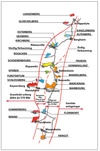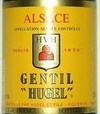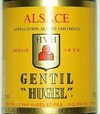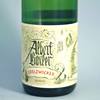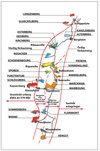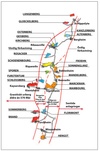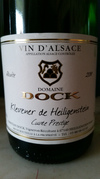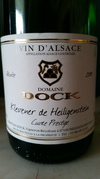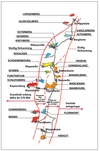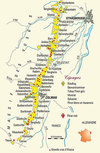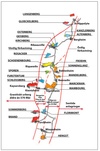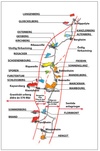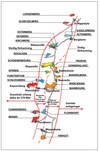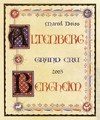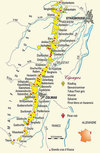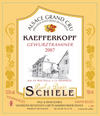Alsace Flashcards
Important Clos Vineyards
(not located within Grand Cru Vineyards)
Clos des Capucins (Kaysersberg, Domaine Weinbach)
Clos de la Faille (Wintzenheim, Albert Mann)
Clos Häuserer (Wintzenheim, Zind-Humbrecht)
Clos Himmelreich (Orschwihr, Lucien Albrecht)
Clos Jebsal (Turckheim, Zind-Humbrecht)
Clos Rebberg (Andlau, Marc Kreydenweiss)
Clos Rebgarten (Andlau, Marc Kreydenweiss)
Clos des Récollets (Rouffach, Lucien Albrecht)
Clos Ribeaupierre (Ribeauvillé, Jean Sipp - formerly known as the Clos du Schlossberg)
Clos Windsbuhl (Hunawihr, Zind-Humbrecht)

Year Alsace achievee AOC status
1963

Moselle AOP
Styles
Major Grapes

- Red, White, Rosé
- Auxerrois
- Pinot Noir
Year Moselle was upgraded from VDQS to AOP
2011

Côtes de Toul AOP
2 grapes for white wines
- Auxerrois
- Aubin
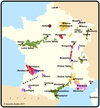
Côtes de Toul AOP
Grape
Pinot Noir

Sparkling Wine
% of Alsace Production
25%

Only AOP in Alsace to allow Chardonnay
Crémant d’Alsace AOP

Workhorse variety for Cremant d’Alsace
Pinot Blanc

Cremant d’Alsace
Styles
Grapes
- Blanc: Riesling, Pinot Blanc, Pinot Noir, Pinot Gris, Auxerrois, Chardonnay
- Rosé: 100% Pinot Noir

Only red variety permitted for Alsace AOP wines
Pinot Noir

SGN Pinot Gris and Gewurztraminer
Min. Must Weight

306 g/l
- formerly 279 g/l
- the highest min. must weights in France

SGN Riesling, Muscat and Muscat Ottonel
Min. Must Weight

276 g/l
(formerly 256 g/l)
VT Pinot Gris and Gewurztraminer
Min. Must Weight

270 g/l

(formerly 257 g/l)
VT Riesling, Muscat and Muscat Ottonel
Min. Must Weight
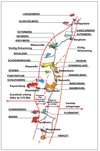
244 g/l

(formerly 235 g/l)
T/F: Vendanges Tardives must be sweet.

False
- VT wines may vary in actual sugar, and can be quite dry

Late-harvest designation that can show botrytis, but emphasizes varietal purity

Vendanges Tardives
Late-harvest designation generally picked in tries, suppresses varietal characteristic for botrytis

Sélections de Grains Nobles

T/F: Vendanges Tardives and Sélections de Grains Nobles are terms that may only be printed on the labels of Alsace Grand Cru AOP.

False
- The terms may be printed on Alsace AOP and Alsace Grand Cru AOP

Year AOP designations for late-harvest wines Vendanges Tardives and Sélections de Grains Nobles were created
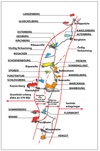
1984

2 Producers who choose not to promote wines as Grand Cru
- Trimbach - Clos-Ste-Hune, Rosacker GC
- Hugel

Largest grand cru of Alsace
- Schlossberg
- 80 ha

Smallest grand cru of Alsace
- Kanzlerberg
- 3 ha
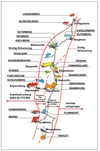
Pinot Gris and Gewurztraminer
Grand Cru AOP
Min. Alcohol
12.5%
- although certain vineyards mandate higher amounts
Riesling and Muscat
Grand Cru AOP
Min. Alcohol
11%
- although certain vineyards mandate higher amounts
Is mechanical harvesting permitted for grand cru wines?
No. Hand-harvesting is mandatory.
Sylvaner is permitted as a varietal wine in what Grand Cru AOP?

Zotzenberg

2 grand crus of Alsace that may blend to certain prescribed proportions
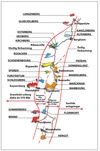
- Altenberg de Bergheim
- Kaefferkopf
51st grand cru added in 2006
Kaefferkopf
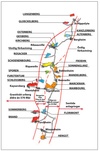
Year Alsace Grand Cru AOP first proposed
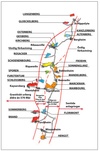
1975

Number of vineyards designated as grand crus in 1983

25



